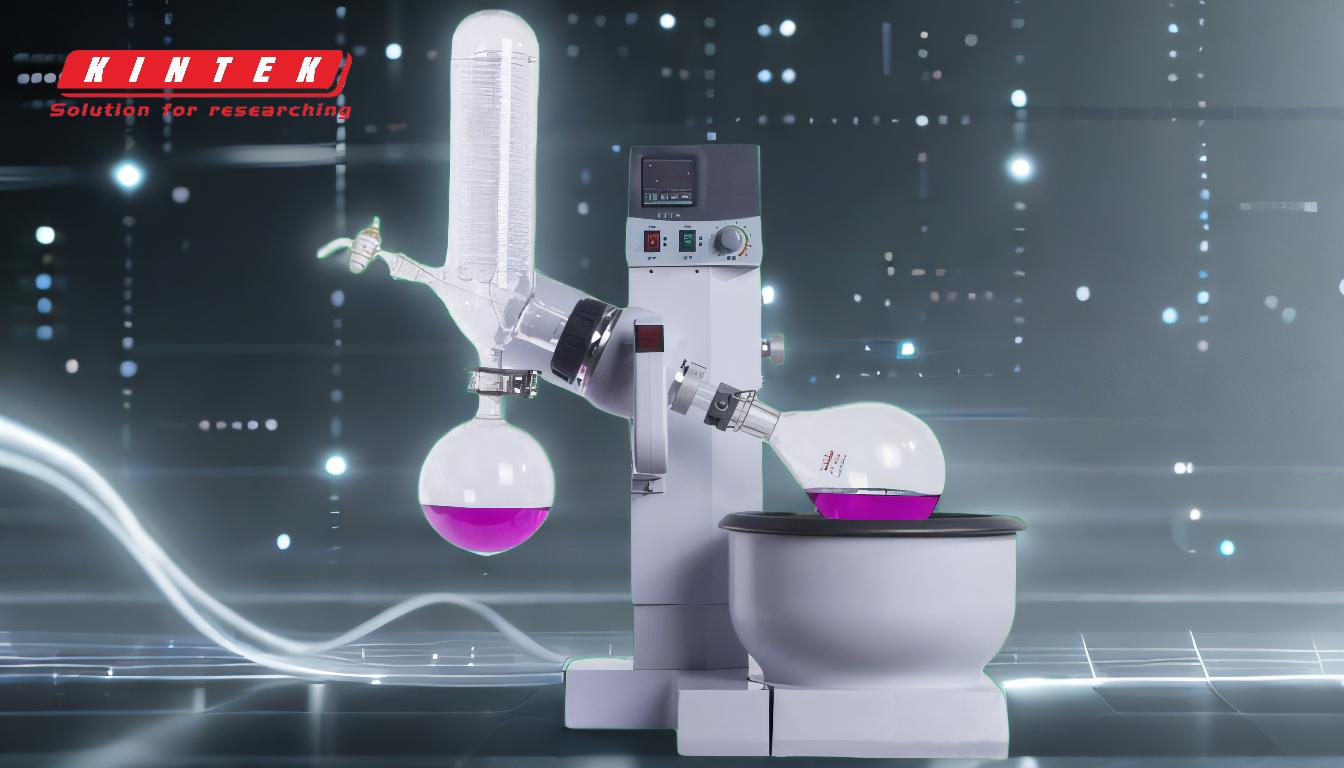Yes, you can remove DMSO (dimethyl sulfoxide) using a rotary evaporator (rotovap). The process involves applying a deep vacuum and moderate heat (around 50 °C) to evaporate the DMSO. After evaporation, the material is often redissolved in a low-boiling-point solvent like dichloromethane (DCM) and then precipitated in a non-solvent such as hexane or diethyl ether. The rotary evaporator is effective for this purpose because it lowers the boiling point of DMSO under vacuum, allowing for its removal at a lower temperature, which minimizes the risk of damaging heat-sensitive compounds.
Key Points Explained:

-
How a Rotary Evaporator Works for DMSO Removal:
- A rotary evaporator works by creating a vacuum in the flask, which lowers the boiling point of the solvent (in this case, DMSO).
- The flask is rotated to increase the surface area of the solvent, promoting faster evaporation.
- The evaporated solvent is condensed on a cooled surface and collected in a separate flask.
- For DMSO, a deep vacuum and moderate heat (around 50 °C) are applied to facilitate evaporation without damaging heat-sensitive materials.
-
Step-by-Step Process for Removing DMSO on a Rotovap:
- Step 1: Turn on the water bath and set it to approximately 50 °C.
- Step 2: Ensure the water condenser is functioning and cold.
- Step 3: Secure the round-bottom flask containing the DMSO solution to the rotovap using a clip.
- Step 4: Turn on the vacuum pump and close the tap to create a reduced pressure environment.
- Step 5: Start the rotation of the flask to create an even coating of the solution on the inner surface.
- Step 6: Lower the flask into the water bath and monitor the process to avoid bumping.
- Step 7: Continue the process until all the DMSO is evaporated.
- Step 8: Raise the flask out of the water bath, stop the rotation, and turn off the vacuum pump.
- Step 9: Carefully open the tap to release the vacuum and remove the flask.
-
Pros of Using a Rotovap for DMSO Removal:
- Efficiency: The rotovap is highly effective at removing DMSO quickly.
- Simplicity: The process is straightforward and does not require additional solvents or chemicals.
- Gentle on Materials: The use of vacuum and moderate heat minimizes the risk of damaging heat-sensitive compounds, although care must still be taken with very delicate materials like peptides or proteins.
-
Cons of Using a Rotovap for DMSO Removal:
- Heat Sensitivity: While the process is generally gentle, prolonged exposure to heat (even at 50 °C) can still damage very sensitive compounds.
- Bumping Risk: DMSO can sometimes cause bumping during evaporation, which can lead to loss of material or contamination. Proper monitoring and gradual vacuum application can mitigate this risk.
-
Post-Rotovap Processing:
- After DMSO removal, the material is often redissolved in a low-boiling-point solvent like dichloromethane (DCM).
- The solution is then precipitated in a non-solvent such as hexane or diethyl ether to isolate the desired compound.
- This step ensures that any residual DMSO is removed and the final product is purified.
-
Considerations for Optimal Results:
- Temperature Control: Ensure the water bath temperature is set correctly to avoid overheating.
- Vacuum Strength: Use a deep vacuum to effectively lower the boiling point of DMSO.
- Rotation Speed: Adjust the rotation speed to ensure an even coating of the solution on the flask walls, promoting efficient evaporation.
- Monitoring: Continuously monitor the process to prevent bumping and ensure complete solvent removal.
By following these steps and considerations, you can effectively remove DMSO using a rotary evaporator while minimizing the risk of damaging sensitive materials.
Summary Table:
| Key Aspect | Details |
|---|---|
| Process Overview | Use a rotary evaporator with deep vacuum and moderate heat (~50 °C). |
| Steps | 1. Set water bath to 50 °C. 2. Secure flask. 3. Apply vacuum. 4. Rotate flask. 5. Monitor evaporation. |
| Pros | Efficient, simple, and gentle on heat-sensitive materials. |
| Cons | Risk of heat sensitivity and bumping during evaporation. |
| Post-Processing | Redissolve in DCM, precipitate in hexane or diethyl ether for purification. |
| Considerations | Control temperature, vacuum strength, rotation speed, and monitor closely. |
Need help with DMSO removal or rotary evaporator setup? Contact our experts today!









